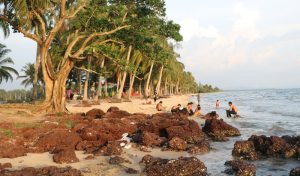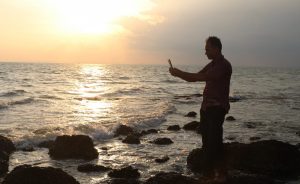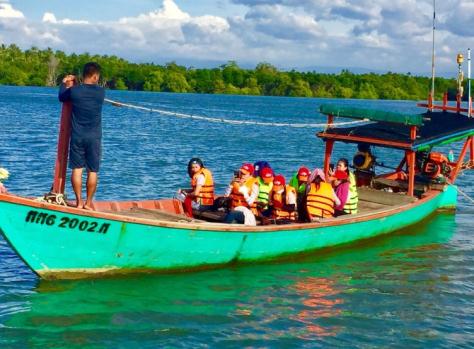Report1
Case Story: Chroy Svay Community Fisheries
 Drive about 165 km from Phnom Penh on National Road No. 4, turn right to continue for another 17 km on National Road No. 48, arrive at an intersection, and then turn left onto the red rock commune road to the Chroy Svay fishing community. The place is very attractive for local, national and international visitors because of its beautiful seaside and mangrove forest, enriched with many varieties of marine fishery resources such as shrimp, crab, snails and fish. There are around 2,000 household members in the Chroy Svay community fishery. Most of them are smallholder fishers.
Drive about 165 km from Phnom Penh on National Road No. 4, turn right to continue for another 17 km on National Road No. 48, arrive at an intersection, and then turn left onto the red rock commune road to the Chroy Svay fishing community. The place is very attractive for local, national and international visitors because of its beautiful seaside and mangrove forest, enriched with many varieties of marine fishery resources such as shrimp, crab, snails and fish. There are around 2,000 household members in the Chroy Svay community fishery. Most of them are smallholder fishers.
“Currently, the women in my community are very busy to earn extra income through seafood processing activities. I notice that there is a remarkable increase in the number of visitors coming to our community for eco-tourism, contrib-uting to increased purchase of our community products and eco-tourism services. Thanks to Morodok for facilitation and support for the strengthening of our community fishery, establishment of eco-tourism, and especially support to seafood processing and marketing. Previously only men who caught fish with their fishing nets could make income selling their fresh fish directly to wholesalers at nonnegotiable prices. Today my community could sell both fresh and processed seafood products, not only to visitors, but also to wholesalers coming to our villages and buying the products at a better price” said Mr. Kun Hok, a leader of the Chroy Svay Community Fishery.
 Mr. Kun Hok added that the Chroy Svay Eco-Tourism project also substantially contributed to increased income for his community members. The visitors can be individuals, groups, companies or organizations. The visitors can visit the mangrove forest, visit the seaside, swim, catch crabs or snails, and go fishing. The beach is close to the homestay so they can see the beautiful sunrise in the early morning and sunset in the evening. They can also order a wonderful breakfast, lunch and dinner with Khmer dishes from the community sellers.
Mr. Kun Hok added that the Chroy Svay Eco-Tourism project also substantially contributed to increased income for his community members. The visitors can be individuals, groups, companies or organizations. The visitors can visit the mangrove forest, visit the seaside, swim, catch crabs or snails, and go fishing. The beach is close to the homestay so they can see the beautiful sunrise in the early morning and sunset in the evening. They can also order a wonderful breakfast, lunch and dinner with Khmer dishes from the community sellers.
The design of Morodok’s program was based on a needs assessment with local communities to make sure that the intervention is highly responsive to the identified needs. Morodok’s program pooled its efforts to improve the co-management of fishery resources and increase opportunities for better livelihoods through increased access to adequate skills, markets and financial services.
AH-report ISLP-B
Background
AFSC has been working partnership with the Ministry of Agriculture, Forestry and Fisheries since 1982. In the 1980s, AFSC worked in mainly in community development, animal health, irrigation and water supply, in Kompong Chhang and Pursat Provinces, as well as technical capacity building at the national level. By the mid-1990s much of this work was complete. Many project activities had become sustainable or could be transferred to larger organizations then beginning to work in Cambodia.
It is AFSC’s aim to focus on helping the poor to better provide for their livelihoods and assisting local authorities in areas that are not being served by another international organization. In 1997, following discussions with officials at the national level and in Koh Kong province, AFSC initiated the Integrated Sustainable Livelihoods Program in Sre Ambel and Kompong Seila districts. At that time, AFSC was the only international NGO with a project based there. Five years later, when the ISLP Strategic Plan was developed, the area continued to be underserved.
While the target districts were initially very isolated and difficult to access, they have undergone rapid change. Major demographic, political and infrastructure changes have significantly altered the socio-economic environment and the use of natural resources in the area. This had a major effect on local communities, who have always depended heavily on natural resources to survive. Main activities have traditionally been logging, collection of forest products, fishing, and basic agriculture.
The 1999 logging ban cut off an important source of income for poor local villagers. Those who remained were motivated to protect their remaining forest area. These communities faced a pressing need to find legal, sustainable ways to make ends meet. However, this transition requires a significant change in livelihood activity and resource use. In 2004, a new road was built linking the area with the Thai border, resulting in the arrival of new stakeholders [outside actors] and further changes to local market economy. Changing and often competing claims on land ownership and use have led to problems such as land speculation, illegal logging and conflict.
For fishing communities situated along Kompong Song Bay, significant pressure has come from illegal mechanised trawlers operating in shallow waters. The resulting decrease in fish yields exacerbated poverty and increased conflict between competing groups, especially as fish stocks in other marine areas collapsed. Villagers sought other means of survival, such as clearing forests for mangrove wood and rice fields, thus creating even more pressure on natural resources.
In parallel, the Sub-decree on Community Forestry (2003) and Sub-decree on Community Fisheries (2005), as well as the Forestry Law (2003) and Fisheries Law (2006) were passed. The drafting of these laws was a positive step towards the establishment of a legal framework for community-based natural resource management in Cambodia. Regulatory changes engaged debate and dialogue between communities, government officials and civil society. When rules are clearly understood and enforced they will help communities and officials to meet the requirements.
The integrated strategy carried out by AFSC in the area reflects the interconnectedness between the health of the natural environment and the wellbeing of the communities. Effective and sustainable community management of natural resources in partnership with official authorities is essential. Such collective management is necessary to protect the environment itself, to prevent conflict between groups, and to preserve people’s livelihoods, both now and for future generations. Continue reading

